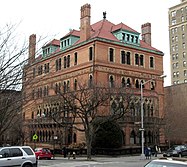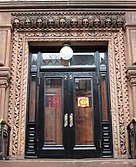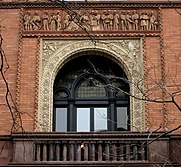
The Chanin Building is a brick and terra-cotta skyscraper located at 122 East 42nd Street, at the corner of Lexington Avenue, in Midtown Manhattan, New York City. Built by Irwin S. Chanin in 1927–1929, it is 56 stories high, reaching 649 feet (198 m) excluding the spire and 680 feet (210 m) including it. It was designed by Sloan & Robertson in the Art Deco style, with the assistance of Chanin's own architect Jacques Delamarre, and it incorporates architectural sculpture by Rene Paul Chambellan. It is the 93rd tallest building in New York.
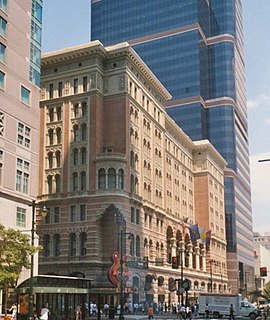
Francis Hatch Kimball was an American architect practicing in New York City, best known for his work on skyscrapers in lower Manhattan and terra-cotta ornamentation. He was an associate with the firm Kimball & Thompson. His work includes the Empire Building, Manhattan Life Insurance Building, and Casino Theatre (Broadway). All but one of Kimball's work was in the United States.

The Bayard–Condict Building at 65 Bleecker Street between Broadway and Lafayette Street, at the head of Crosby Street in the NoHo neighborhood of Manhattan, New York City is the only work of architect Louis Sullivan in New York City. It was built between 1897 and 1899 in the Chicago School style; the associate architect was Lyndon P. Smith. The building was originally known as the Condict Building before being renamed the Bayard Building. The building was considered to be a radical design for its time, since it contravened the strictures of American Renaissance architecture which were the accepted status quo, but had little influence on architectural design in New York City, because of its location in the industrial area that Bleecker Street was during that period. It is located in the NoHo Historic District.
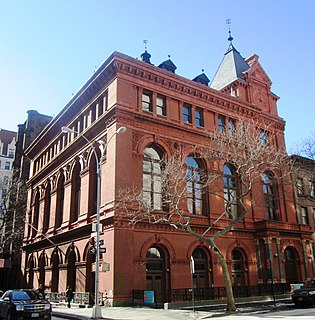
The Brooklyn Historical Society (BHS), founded in 1863, is a museum, library, and educational center preserving and encouraging the study of Brooklyn's 400-year history. The society's Romanesque Revival building, located at Pierrepont and Clinton Streets in Brooklyn Heights, was designed by George B. Post and built in 1878-81, is a National Historic Landmark and part of New York City's Brooklyn Heights Historic District. The Brooklyn Historical Society houses materials relating to the history of Brooklyn and its people, and hosts exhibitions which draw over 9,000 members a year. In addition to general programming, BHS serves over 70,000 public school students and teachers annually by providing exhibit tours, educational programs and curricula, and making its professional staff available for instruction and consultation.

St. Cecilia Church is a Roman Catholic parish church in the Roman Catholic Archdiocese of New York and a historic landmark located at 120 East 106th Street between Park Avenue and Lexington Avenue, Manhattan, New York City, New York. The parish was established in 1873. It was staffed by the Redemptorist Fathers from 1939-2007. The church was designated a New York City landmark in 1976. The church and convent were listed on the U.S. National Register of Historic Places in 1984.

The Corbin Building is a historic office building located at 13 John Street at the corner of Broadway – where it is numbered as 192 – in the Financial District of Manhattan, New York City. It was built in 1888-89 and was designed by Francis H. Kimball in the Romanesque Revival style with French Gothic detailing. The building was named for Austin Corbin, a president of the Long Island Rail Road who also founded several banks. It was built as a speculative venture for use as office space or housing.

Congregation Magen David Synagogue is a historic Sephardic Syrian-Jewish synagogue located in the Bensonhurst neighborhood of Brooklyn, Kings County, New York. Erected in 1920-1921, the synagogue was at its height of popularity during the 1940s, 1950s, and early 1960s. The synagogue is still in continual use for daily and Shabbat prayers. It is a two-story, Romanesque Revival style brick building on a raised basement. It features a variety of brick designs and stone details, round arched windows, and a red terra cotta clad tile roof.

The Fort Washington Avenue Armory, also known as the Fort Washington Armory, The Armory, and the 22nd Regiment Armory, is a historic armory building located at 216 Fort Washington Avenue, between West 168th and 169th Streets, in the Washington Heights neighborhood of Manhattan, New York City. It is a brick Classical Revival building with Romanesque Revival elements, such as the entrance arch, and is currently home to the National Track and Field Hall of Fame, New Balance Track and Field Center, and other organizations including the Police Athletic League of New York City.

The Bushwick Democratic Club House was a building located in Bushwick, Brooklyn, New York City. The building, designed by Brooklyn-based architect Frank Freeman in his signature Richardsonian Romanesque style, was completed in 1892, and designated a New York City Landmark in the 1970s. It was later destroyed by fire.

The Germania Club House was a building located in Boerum Hill, Brooklyn, New York. Designed by Frank Freeman and completed in 1890, it was considered one of Brooklyn's finest examples of Romanesque Revival architecture. It was demolished in the 1920s to make way for a subway.

The Crescent Athletic Club House is a building at 129 Pierrepont Street at the corner of Clinton Street in Brooklyn Heights, Brooklyn, New York City. Designed by prominent Brooklyn-based architect Frank Freeman and completed in 1906, the building is known today as the Bosworth Building of Saint Ann's School.

The Herman Behr Mansion is a building located at 82 Pierrepont Street at the corner of Henry Street in Brooklyn Heights, Brooklyn, New York City. Constructed in 1888-89 to a design of Brooklyn architect Frank Freeman, it has been described as "the city's finest Romanesque Revival house".

47 Plaza Street West is an apartment building designed by the noted architect Rosario Candela and completed in 1928 in Park Slope, Brooklyn, New York City. The building, located next to Brooklyn's Grand Army Plaza, possesses a distinctive flatiron shape.

The Church of Our Lady of Esperanza is a Roman Catholic parish church in the Roman Catholic Archdiocese of New York, located at 624 West 156th Street between Broadway and Riverside Drive in the Washington Heights neighborhood of Upper Manhattan in New York City.

The Astral Apartments is an apartment building located at 184 Franklin Street in Greenpoint, Brooklyn, New York City. The Astral was built in 1885–1886 as affordable housing for employees of Charles Pratt's Astral Oil Works. It is a block-long brick and terra cotta building in the Queen Anne style. It features a central projecting section with a deep, three-story-high round arch recess. The roof features inward-looking decorative gargoyles. Original amenities of the building included a settlement house, library, and kindergarten.

Renaissance Apartments is a historic apartment building located at Hancock Street and Nostrand Avenue in Bedford-Stuyvesant, Brooklyn, New York, New York. It was built in 1892 and is a five-story masonry building in the French Renaissance style. It features elaborately decorated principal facades and prominent circular corner towers with slate covered conical roofs. It has steeply sloped slate mansard roofs with terra cotta ridge caps and gabled roof dormers.

Public Bath No. 7 is a historic bathhouse located in Park Slope, Brooklyn, New York City. It was built between 1906 and 1910 and is constructed of white glazed brick and limestone colored terra cotta blocks. The design is based on a Renaissance palazzo. It measures three bays by five bays. The bathhouse was converted to a gymnasium in 1937.

Lincoln Club, also known as Mechanics Temple, Independent Order of Mechanics of the Western Hemisphere, is a historic clubhouse in Clinton Hill, Brooklyn, New York, New York. It was built between 1886 and 1889 and is a 3 1⁄2-story Queen Anne style masonry building. It is built of Roman brick and rock-faced Lake Superior brownstone with smooth brownstone bands and terra cotta ornament. It has a sunken basement and the front facade features four distinctive arches on the first floor and a 2-story oriel window.

The 14th Regiment Armory, also known as the Eighth Avenue Armory and the Park Slope Armory, is a historic National Guard armory building located on Eighth Avenue between 14th and 15th Streets in the South Slope neighborhood of Brooklyn, New York City, United States. The building is a brick and stone castle-like structure, and designed to be reminiscent of medieval military structures in Europe. It was built in 1891–95 and was designed in the Late Victorian style by William A. Mundell.
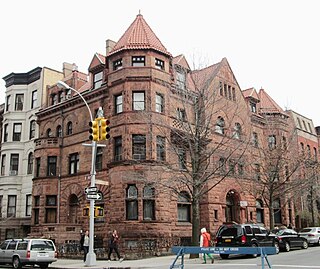
115–119 Eighth Avenue, also known as the Adams House, is a historic house at Eighth Avenue and Carroll Street in Park Slope, Brooklyn, New York City. It was built in 1888 as a double house, and was commissioned by Thomas Adams Jr., who invented the Adams Chiclets automatic vending machine. It was designed by noted architect C. P. H. Gilbert in the Richardsonian Romanesque style, and is considered to be one the best examples of that style extant in New York City, "worthy of H. H. Richardson." The house is built of sandstone, terra cotta and brick on a brownstone base, and was the first house in the neighborhood with an elevator. It has now been converted into apartments.

